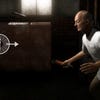Your Move
PS3’s back catalogue gets motion sensitive.
If you've been keeping a weather eye on PlayStation Move coverage, you've probably come to the conclusion that Sony's latest foray into motion control is an extremely competent peripheral in search of genuinely good games. Luckily, the PlayStation 3 already had some genuinely good games knocking about, and now some of them have had Move support patched in.
These aren't system-sellers, then, but they aren't really meant to be. Rather, think of them as a potential added bonus, and a decent glimpse of what developers can do with the tech in a short space of time. Was it all worth it? How well do they work? Why did Patrick Duffy struggle to find meaningful roles after Dallas? All but one of these questions will be answered below.
[Note: in all the cases listed, the left side of the DualShock 3 or Sixaxis works just as well as the Navigation controller.]
Heavy Rain
[Warning – contains the odd spoiler.]
I was so emotionally engaged with the taut and multi-textured psychodrama of Heavy Rain on my first playthrough that, once it was finished, I grew a beard, broke up with my wife, and arranged to have one of my children wedged into a drain. Actually, I did none of these things, but I did think, "Ooh, I bet that game would work well with Move controls. (And some decent actors.)"
Right again, me. Heavy Rain: Move Edition takes a bit of, um, acclimatisation, but it reeks of attention to detail.
Good news: if you hated the walking mechanic of the original, it's gone, replaced with a more standard set-up roping in the Navigation controller's thumbstick. Getting around is a lot easier, then – and you can move the camera a bit at the same time with the Move itself – but most of the new interactions will require a half-hour or so to really get used to them.
It's worth it, though. The bulk of your fun involves squeezing the Move's trigger and moving the controller through the air either horizontally or vertically. After a while, even the tricky stuff starts to feel fairly natural, and when it finally clicks and you're doling out cash, unlocking doors or, I don't know, chopping an appendage off, it can seem rather pleasantly like you've become a mime – which is probably what that haughty Parisian David Cage had in mind all along.
Pushing and pulling actions give the game a physicality it missed before, and Quantic Dream seems to have taken real care throughout, finding intelligent and interesting analogues for the original moves, whether you're selecting thoughts by highlighting them with a pointer or engaging in a wheezy fist fight. I still got the worst ending, of course, but, to be honest, I never really liked that kid in the first place.




